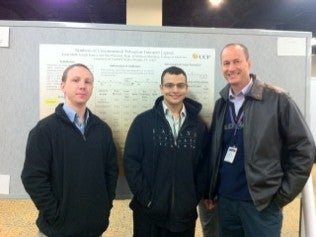The American Chemical Society is the leading chemistry organization in America, with more than 150,000 members. As a medicinal chemist, Phanstiel uses organic chemistry to develop new therapeutics and drug-delivery systems.
Phanstiel, graduate student Aaron Muth and undergraduate student Joseph Kamel presented their research on polyamines — molecules that are important growth factors for cells. Polyamines are present in all living cells and cells can either make them or import them to facilitate their own growth. Certain cancer cells use their polyamine transporters to feed off the polyamines of neighboring cells to grow, multiply and spread. This polyamine transport activity is especially prevalent in colon and pancreatic cancers.
Phanstiel’s team is looking at two anti-cancer strategies related to polyamines. First is using the polyamines’ active transport system to selectively deliver toxic drugs to cancer cells. “It’s the poison Big Mac approach to cancer therapy,” Phanstiel said. “Poison the Big Mac and he who eats the most, dies the fastest.” By connecting polyamines to cytotoxic drugs, the new drug conjugate (i.e., the poison Big Mac) can selectively enter and kill the cancer cells. Because the drugs are delivered selectively at the cellular level, this treatment approach should be less toxic to the patient than traditional chemotherapy, which is typically non-selective. A second approach is to create drugs that inhibit the cell’s source of polyamines altogether. “You basically block the entrance (transporter) and you block the cell’s polyamine factory,” Phanstiel said, causing the cancer cell to starve to death.
Phanstiel also presented a lecture at the American Chemical Society on motuporamine C, a naturally-occurring polyamine found in the blue sponges of New Guinea. Scientists had previously discovered that extracts from the blue sponges had strong anti-cancer properties, including the ability to block the spread of cancers. By synthesizing this natural product and making derivatives, his team is looking at ways to create motuporamine mimics which have optimized anti-cancer properties.
The College of Medicine team gave two oral and one poster presentation of their work and the experience gave students an opportunity to explain their findings and answer questions from fellow scientists. “Presentations like this show students the impact of their work,” Phanstiel said. “I can’t think of a better validation of the graduate education process than students presenting their research to an audience of professionals and successfully answering questions on their own.” Drug discovery is a team sport and Phanstiel collaborated with Drs. Cheryl Baker (cancer biologist), Fred Breitbeil (molecular modeler) and Laurence von Kalm (geneticist) on this project.
